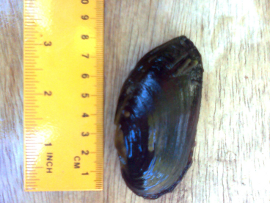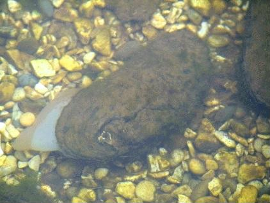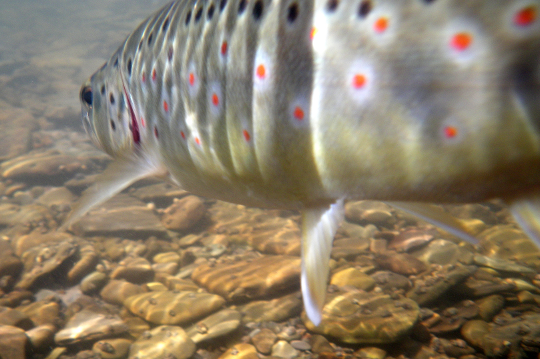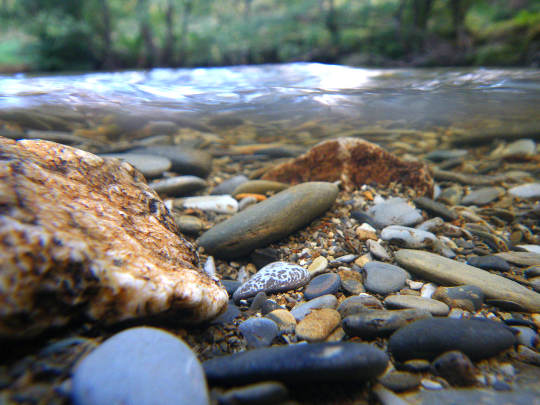Freshwater pearl mussel (Margaritifera margaritifera)
The freshwater pearl mussel grows to 140 mm in length and burrows into sandy substrates, often between boulders and pebbles in fast-flowing rivers and streams. It requires cool, well-oxygenated soft water free of pollution or turbidity. The mussel spends its larval, or glochidial, stage attached to the gills of salmonid fishes, thereby progressing upstream. The larvae attach themselves during mid to late summer and drop off the following spring to settle in the riverbed gravel. They spend 5-7 years living within the gravel before emerging as filter feeding mussels.


Freshwater pearl mussel (Margaritifera margaritifera). The far right image shows a young Pearl mussel (30 years old!). They are easily identified from other UK mussels by the dark shell and characteristic erosion around the hinge created by decades of moving around in the gravel. (EAW photo)
In the Irfon population declines have been caused by factors such as historic pearl-fishing, acidification, siltation, and declining salmonid stocks. This is now a rare species whose conservation gives rise to concerns and its increasing rarity in mainland Europe gives extra significance to UK populations.
As this species does not reach reproductive maturity until at least 12 years old and may live for over 120 years, details of the population age-structure are vitally important when assessing viability. The presence of juveniles (a feature essential to the long-term sustainability of mussel populations) is a clear indicator of the structural and functional features of the habitat required for the survival and reproduction of the species.

Mussels 'move upstream' by releasing spats (larval stage) into the water which are then transported upriver in the gills of migrating salmonids.
The Freshwater pearl mussel is widely distributed in Europe and north-eastern North America, but has suffered serious decline and is threatened with extinction or is highly vulnerable in every part of its former range. It is listed as 'vulnerable' by IUCN, but is believed to be even more threatened. Outside Britain and Ireland, recruiting populations of international importance survive in probably fewer than 50 rivers world-wide (Young et al. 2001). Only a few viable populations survive in mainland Europe, most remaining continental populations consisting of mussels at least 30 years old with few signs of recent recruitment - although an apparent absence of juveniles may in some cases be partly due to difficulties in surveying.
Margaritifera margaritifera was formerly widespread throughout western and northern parts of Great Britain. However, England and Wales are each now believed to support only a single recruiting population. In Northern Ireland the species formerly occurred widely in several catchments, but is now restricted to a few sites. Many UK rivers now contain only scattered individuals, with no juvenile mussels recorded; such populations may become extinct due to lack of recruitment. Despite serious declines in both range and total population, Scotland is the remaining European stronghold for M. margaritifera, supporting functional populations in over 50 rivers, mainly in the Highlands.
What ISAC will do for FWPMs
The snorkel survey of Irfon Pearl mussels last spring discovered a rather better stock than expected. Amazingly, these animals live for the best part of a century. Initially it seemed that the Irfon population contained only older specimens. However, in a couple of sites, some comparatively young mussels were found and the Irfon has one of the best populations in Wales.

Water quality is a major factor that determines the health of FWPM populations.
Pearl mussels are one of the casualties of increased siltation as a result of land use changes and this project offers real hope for this beleaguered species. Their survival depends on clean silt free gravels for the younger stages to move around in and the unique relationship that exists between mussels and salmonids. It is therefore of crucial importance to them that sufficient numbers of salmon and trout are present in the Irfon and proceed well upstream.
The project is targeting its actions at supporting the existing wild populations by reducing acidity from the forested areas and reducing the fine sediment loadings currently being sourced to the river from bank and drain erosion. Further we are developing a captive breeding programme to establish a new generation of mussels.
For details of the work carried out within the project, please click here.
